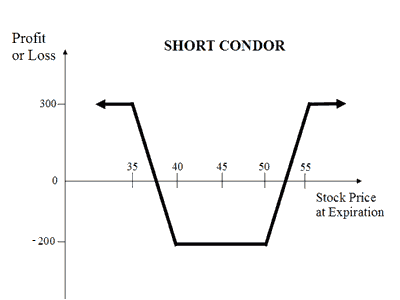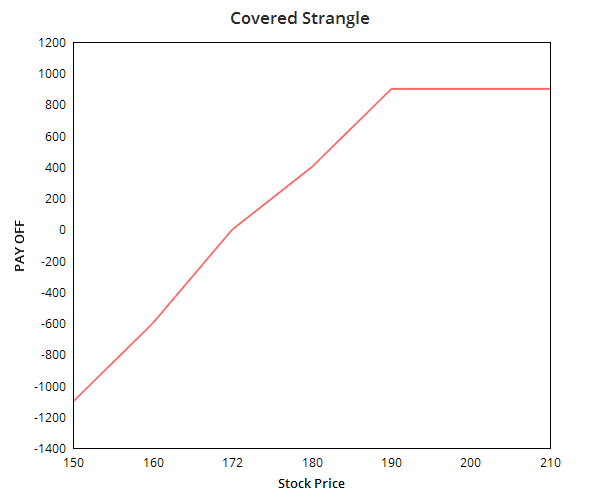 Zerodha (Trading & Demat Account)
Zerodha (Trading & Demat Account)
FREE Equity Delivery and MF
Flat ₹20/trade Intra-day/F&O
 Zerodha (Trading & Demat Account)
Zerodha (Trading & Demat Account)
FREE Equity Delivery and MF
Flat ₹20/trade Intra-day/F&O

|
|
Compare Short Condor (Short Call Condor) and Covered Strangle options trading strategies. Find similarities and differences between Short Condor (Short Call Condor) and Covered Strangle strategies. Find the best options trading strategy for your trading needs.
| Short Condor (Short Call Condor) | Covered Strangle | |
|---|---|---|
 |
 |
|
| About Strategy | A Short Call Condor (or Short Condor) is a neutral strategy with a limited risk and a limited profit. The short condor strategy is suitable for a high volatile underlying. The goal of this strategy is to profit from a stock price moving up or down beyond the highest or lowest strike prices of the position. The strategy is similar to Short Call Butterfly strategy with the difference being in the strike prices selected. Suppose Nifty is currently trading at 10,400. If the trader is expecting high volatility in the index due to specific events i.e. budget, results, and elections, he could choose the Short Condor strategy to profit in such a market scenario. The strategy could be constructed as below: Short Condor Options Strategy ... Read More | The covered strangle option strategy is a bullish strategy. The strategy is created by owning or buying a stock and selling an OTM Call and OTM Put. It is called covered strangle because the upside risk of the strangle is covered or minimized. The strategy is perfect to use when you are prepared to sell the holding or bought shares at a higher price if the market moves up but would also is ready to buy more shares if the market moves downwards. The profit and in this strategy is unlimited while the risk is only on the downside. |
| Market View | Volatile | Bullish |
| Strategy Level | Advance | Advance |
| Options Type | Call | Call + Put + Underlying |
| Number of Positions | 4 | 3 |
| Risk Profile | Limited | Limited |
| Reward Profile | Limited | Limited |
| Breakeven Point | two break-even points | |
| Short Condor (Short Call Condor) | Covered Strangle | |
|---|---|---|
| When to use? | The Short Call Condor works well when you expect the price of the underlying to be very volatile. In other words, when the trader is anticipating massive price movements (in any direction) in the underlying during the lifetime of the options. |
A covered strangle strategy can be used when you are bullish on the market but also want to cover any downside risk. You are prepared to sell the shares on profit but are also willing to buy more shares in case the prices fall. |
| Market View | Volatile When you are unsure about the direction in the movement in the price of the underlying but are expecting high volatility in it in the near future. |
Bullish The Strategy is perfect to apply when you're bullish on the market and expecting less volatility in the market. |
| Action | Buy ITM Call Option + Buy OTM Call Option + Sell Deep OTM Call Option + Sell Deep ITM Call Option Suppose Nifty is trading at 10,400. If you expect high volatility in the Nifty in the coming days then you can execute Short Call Condor by selling 1 ITM Nifty Call at 10,200, buying 1 ITM Call at 10,300, buying 1 OTM Call Option at 10, 500 and selling 1 OTM Nifty Call at 10, 600. Your maximum loss will be if Nifty closes in the range of 10,300 to 10,500 on expiry while maximum profit will be on either side of upper or lower strikes. |
Buy 100 shares + Sell OTM Call +Sell OTM Put The covered strangle options strategy can be executed by buying 100 shares of a stock while simultaneously selling an OTM Put and Call of the same the stock and similar expiration date. |
| Breakeven Point | There are 2 break even points in this strategy. The upper break even is hit when the underlying price is equal to the difference between strike price of highest strike shot call and net premium paid. The lower break even is hit when the underlying price is equal to the strike price of lowest strike short call and net premium paid. Lower Breakeven = Lower Strike Price + Net Premium Upper breakeven = Higher Strike Price - Net Premium |
two break-even points There are 2 break-even points in the covered strangle strategy. One is the Upper break even point which is the sum of strike price of the Call option and premium received while the other is the lower break-even point which is the difference strike price of short Put and premium received. |
| Short Condor (Short Call Condor) | Covered Strangle | |
|---|---|---|
| Risks | Limited This is a limited risk strategy. The maximum risk in a short call condor strategy is calculated as below: Max Loss = Strike Price of Lower Strike Long Call - Strike Price of Lower Strike Short Call - Net Premium Received + Commissions Paid The max risk is when the price of the underlying remains in between strike price of 2 long calls. |
Limited The risk on this strategy is only on the downside when the price moves below the strike price of the Put option. |
| Rewards | Limited The maximum profit in a short call condor strategy is realized when the price of the underlying is trading outside the range at time of expiration.<.p> Max Profit = Strike Price of Lower Strike Short Call - Strike Price of Lower Strike Long Call - Net Premium Paid |
Limited The maximum profit on this strategy happens when the stock price is above the call price on expiry. The profit is the total of the gain from buying/selling stocks and net premium received on selling options. |
| Maximum Profit Scenario | All options exercised or not exercised |
You will earn the maximum profit when the price of the stock is above the Call option strike price on expiry. You will be assigned on the Call option, would be able to sell holding shares on profit while retaining the premiums received while selling the options. |
| Maximum Loss Scenario | Both ITM Calls exercised |
The maximum loss would be when the stock price falls drastically and turns worthless. The premiums received while selling the options will compensate for some of the loss. |
| Short Condor (Short Call Condor) | Covered Strangle | |
|---|---|---|
| Advantages | It allows you to profit from highly volatile underlying assets moving in any direction. The maximum profit for the condor trade may be low in relation to other trading strategies but it has a comparatively wider profit zone. Earn profit with little or no investment as you will have a credit of net premiums. |
|
| Disadvantage | Strike prices selected may have an impact on the potential of profit. Brokerage and taxes make a significant impact on the profits from this strategy. The cost of trading increases with the number of legs. This strategy has 4 legs and thus the brokerage cost is higher. |
|
| Simillar Strategies | Long Put Butterfly, Short Call Condor, Short Strangle | Long Strangle, Short Strangle |

Add a public comment...

FREE Intraday Trading (Eq, F&O)
Flat ₹20 Per Trade in F&O
|
|